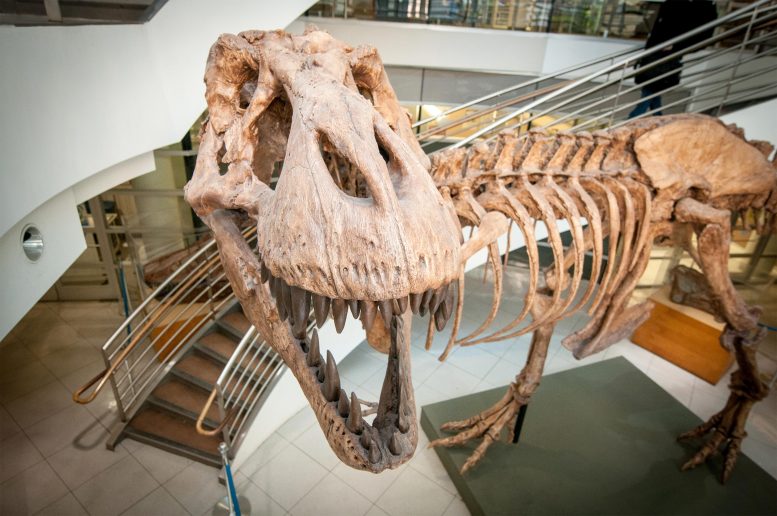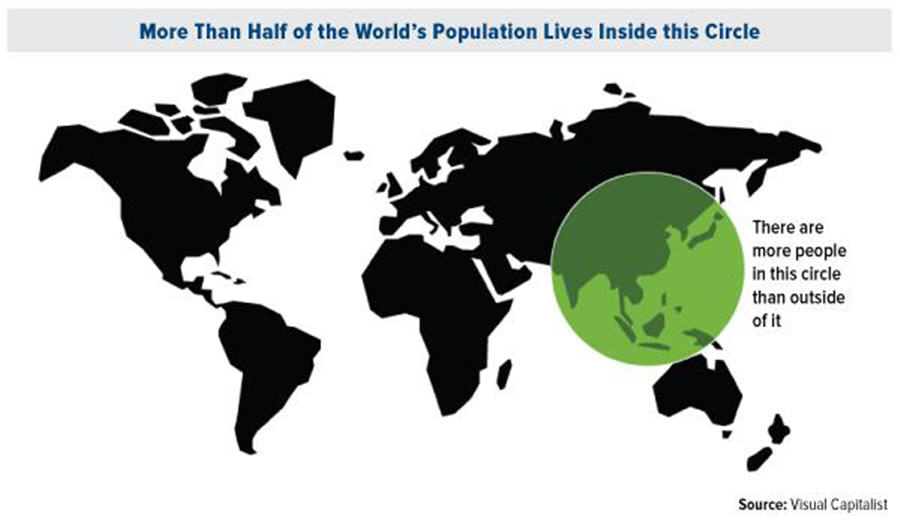
Analysis of what’s known about the dinosaur leads to conclusion there were 2.5 billion over time.
How many Tyrannosaurus rexes roamed North America during the Cretaceous period?
That’s a question Charles Marshall pestered his paleontologist colleagues with for years until he finally teamed up with his students to find an answer.
What the team found, to be published this week in the journal Science, is that about 20,000 adult T. rexes probably lived at any one time, give or take a factor of 10, which is in the ballpark of what most of his colleagues guessed.
What few paleontologists had fully grasped, he said, including himself, is that this means that some 2.5 billion lived and died over the approximately 2 1/2 million years the dinosaur walked the earth.
Until now, no one has been able to compute population numbers for long-extinct animals, and George Gaylord Simpson, one of the most influential paleontologists of the last century, felt that it couldn’t be done.
Marshall, director of the University of California Museum of Paleontology, the Philip Sandford Boone Chair in Paleontology and a UC Berkeley professor of integrative biology and of earth and planetary science, was also surprised that such a calculation was possible.

A cast of a T. rex skeleton on display outside the UC Museum of Paleontology at the University of California, Berkeley. The original, a nearly complete skeleton excavated in 1990 from the badlands of eastern Montana, is at the Museum of the Rockies in Bozeman, Montana. Credit: Keegan Houser, UC Berkeley
“The project just started off as a lark, in a way,” he said. “When I hold a fossil in my hand, I can’t help wondering at the improbability that this very beast was alive millions of years ago, and here I am holding part of its skeleton — it seems so improbable. The question just kept popping into my head, ‘Just how improbable is it? Is it one in a thousand, one in a million, one in a billion?’ And then I began to realize that maybe we can actually estimate how many were alive, and thus, that I could answer that question.”
Marshall is quick to point out that the uncertainties in the estimates are large. While the population of T. rexes was most likely 20,000 adults at any give time, the 95% confidence range — the population range within which there’s a 95% chance that the real number lies — is from 1,300 to 328,000 individuals. Thus, the total number of individuals that existed over the lifetime of the species could have been anywhere from 140 million to 42 billion.
“As Simpson observed, it is very hard to make quantitative estimates with the fossil record,” he said. “In our study, we focused in developing robust constraints on the variables we needed to make our calculations, rather than on focusing on making best estimates, per se.”
He and his team then used Monte Carlo computer simulation to determine how the uncertainties in the data translated into uncertainties in the results.
The greatest uncertainty in these numbers, Marshall said, centers around questions about the exact nature of the dinosaur’s ecology, including how warm-blooded T. rex was. The study relies on data published by John Damuth of UC Santa Barbara that relates body mass to population density for living animals, a relationship known as Damuth’s Law. While the relationship is strong, he said, ecological differences result in large variations in population densities for animals with the same physiology and ecological niche. For example, jaguars and hyenas are about the same size, but hyenas are found in their habitat at a density 50 times greater than the density of jaguars in their habitat.
“Our calculations depend on this relationship for living animals between their body mass and their population density, but the uncertainty in the relationship spans about two orders of magnitude,” Marshall said. “Surprisingly, then, the uncertainty in our estimates is dominated by this ecological variability and not from the uncertainty in the paleontological data we used.”
As part of the calculations, Marshall chose to treat T. rex as a predator with energy requirements halfway between those of a lion and a Komodo dragon, the largest lizard on Earth.
The issue of T. rex’s place in the ecosystem led Marshall and his team to ignore juvenile T. rexes, which are underrepresented in the fossil record and may, in fact, have lived apart from adults and pursued different prey. As T. rex crossed into maturity, its jaws became stronger by an order of magnitude, enabling it to crush bone. This suggests that juveniles and adults ate different prey and were almost like different predator species.
This possibility is supported by a recent study, led by evolutionary biologist Felicia Smith of the University of New Mexico, which hypothesized that the absence of medium-size predators alongside the massive predatory T. rex during the late Cretaceous was because juvenile T. rex filled that ecological niche.
What the fossils tell us
The UC Berkeley scientists mined the scientific literature and the expertise of colleagues for data they used to estimate that the likely age at sexual maturity of a T. rex was 15.5 years; its maximum lifespan was probably into its late 20s; and its average body mass as an adult — its so-called ecological body mass, — was about 5,200 kilograms, or 5.2 tons. They also used data on how quickly T. rexes grew over their life span: They had a growth spurt around sexual maturity and could grow to weigh about 7,000 kilograms, or 7 tons.
From these estimates, they also calculated that each generation lasted about 19 years, and that the average population density was about one dinosaur for every 100 square kilometers.
Then, estimating that the total geographic range of T. rex was about 2.3 million square kilometers, and that the species survived for roughly 2 1/2 million years, they calculated a standing population size of 20,000. Over a total of about 127,000 generations that the species lived, that translates to about 2.5 billion individuals overall.
With such a large number of post-juvenile dinosaurs over the history of the species, not to mention the juveniles that were presumably more numerous, where did all those bones go? What proportion of these individuals have been discovered by paleontologists? To date, fewer than 100 T. rex individuals have been found, many represented by a single fossilized bone.
“There are about 32 relatively well-preserved, post-juvenile T. rexes in public museums today,” he said. “Of all the post-juvenile adults that ever lived, this means we have about one in 80 million of them.”
“If we restrict our analysis of the fossil recovery rate to where T. rex fossils are most common, a portion of the famous Hell Creek Formation in Montana, we estimate we have recovered about one in 16,000 of the T. rexes that lived in that region over that time interval that the rocks were deposited,” he added. “We were surprised by this number; this fossil record has a much higher representation of the living than I first guessed. It could be as good as one in a 1,000, if hardly any lived there, or it could be as low as one in a quarter million, given the uncertainties in the estimated population densities of the beast.”
Marshall expects his colleagues will quibble with many, if not most, of the numbers, but he believes that his calculational framework for estimating extinct populations will stand and be useful for estimating populations of other fossilized creatures.
“In some ways, this has been a paleontological exercise in how much we can know, and how we go about knowing it,” he said. “It’s surprising how much we actually know about these dinosaurs and, from that, how much more we can compute. Our knowledge of T. rex has expanded so greatly in the past few decades thanks to more fossils, more ways of analyzing them and better ways of integrating information over the multiple fossils known.”
The framework, which the researchers have made available as computer code, also lays the foundation for estimating how many species paleontologists might have missed when excavating for fossils, he said.
“With these numbers, we can start to estimate how many short-lived, geographically specialized species we might be missing in the fossil record,” he said. “This may be a way of beginning to quantify what we don’t know.”
Marshall’s co-authors are UC Berkeley undergraduate Connor Wilson and graduate students Daniel Latorre, Tanner Frank, Katherine Magoulick, Joshua Zimmt and Ashley Poust, who is now a postdoctoral fellow at the San Diego Natural History Museum.
